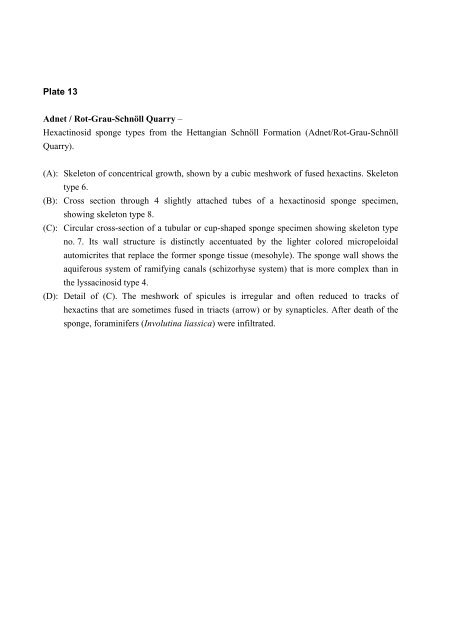Porifera-microbialites of the Lower Liassic (Northern Calcareous ...
Porifera-microbialites of the Lower Liassic (Northern Calcareous ...
Porifera-microbialites of the Lower Liassic (Northern Calcareous ...
Create successful ePaper yourself
Turn your PDF publications into a flip-book with our unique Google optimized e-Paper software.
Plate 13<br />
Adnet / Rot-Grau-Schnöll Quarry –<br />
Hexactinosid sponge types from <strong>the</strong> Hettangian Schnöll Formation (Adnet/Rot-Grau-Schnöll<br />
Quarry).<br />
(A): Skeleton <strong>of</strong> concentrical growth, shown by a cubic meshwork <strong>of</strong> fused hexactins. Skeleton<br />
type 6.<br />
(B): Cross section through 4 slightly attached tubes <strong>of</strong> a hexactinosid sponge specimen,<br />
showing skeleton type 8.<br />
(C): Circular cross-section <strong>of</strong> a tubular or cup-shaped sponge specimen showing skeleton type<br />
no. 7. Its wall structure is distinctly accentuated by <strong>the</strong> lighter colored micropeloidal<br />
automicrites that replace <strong>the</strong> former sponge tissue (mesohyle). The sponge wall shows <strong>the</strong><br />
aquiferous system <strong>of</strong> ramifying canals (schizorhyse system) that is more complex than in<br />
<strong>the</strong> lyssacinosid type 4.<br />
(D): Detail <strong>of</strong> (C). The meshwork <strong>of</strong> spicules is irregular and <strong>of</strong>ten reduced to tracks <strong>of</strong><br />
hexactins that are sometimes fused in triacts (arrow) or by synapticles. After death <strong>of</strong> <strong>the</strong><br />
sponge, foraminifers (Involutina liassica) were infiltrated.

















